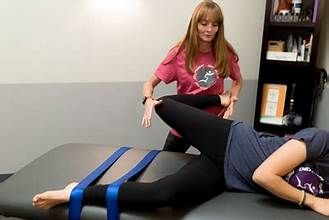Fascia Adhesions
Happy and healthy fascia is hydrated and continuous. In this case, movement is typically easy, pain-free, and efficient within the joint and beyond.
Now imagine that continuous line of fascia being super rigid or being disrupted in some way. This occurs when the collagen fibers of fascia build up and become stiff or locked. Movement would then become difficult, less efficient, and even painful.
Due to the continuous ‘knitted’ formation of fascia, one restriction can lead to another further down the chain. During this ripple effect, fibers are unable to communicate, cooperate and glide optimally with the other components of the system.
Let us use an ankle injury for example. An ankle injury can become dysfunction in the movement at your hip, which can then lead to stiffness and pain in your lower back. With that said, addressing the entire fascial network, or stretching the complete fascial line from head to toe can have a positive cascading effect on tension throughout the body, and in the initial point of disruption.
WHEN DO FASCIA ADHESIONS OCCUR?
Fascia adhesions tend to occur at these congested areas after injury, surgery, inflammation, repetitive movement, or even after lack of movement (ex. sedentary lifestyle, injury recovery, poor posture).
Now imagine that continuous line of fascia being super rigid or being disrupted in some way. This occurs when the collagen fibers of fascia build up and become stiff or locked. Movement would then become difficult, less efficient, and even painful.
Due to the continuous ‘knitted’ formation of fascia, one restriction can lead to another further down the chain. During this ripple effect, fibers are unable to communicate, cooperate and glide optimally with the other components of the system.
Let us use an ankle injury for example. An ankle injury can become dysfunction in the movement at your hip, which can then lead to stiffness and pain in your lower back. With that said, addressing the entire fascial network, or stretching the complete fascial line from head to toe can have a positive cascading effect on tension throughout the body, and in the initial point of disruption.
WHEN DO FASCIA ADHESIONS OCCUR?
Fascia adhesions tend to occur at these congested areas after injury, surgery, inflammation, repetitive movement, or even after lack of movement (ex. sedentary lifestyle, injury recovery, poor posture).
